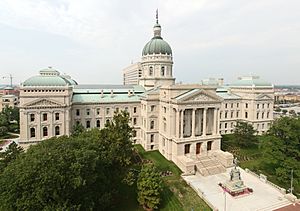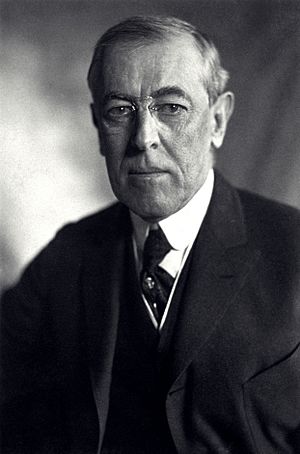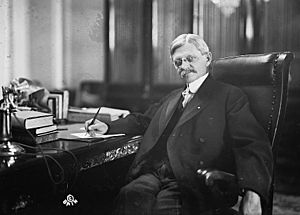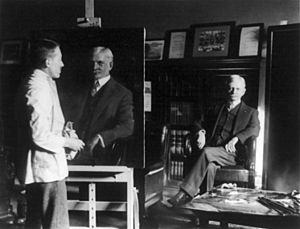Thomas R. Marshall facts for kids
Quick facts for kids
Thomas Marshall
|
|
|---|---|
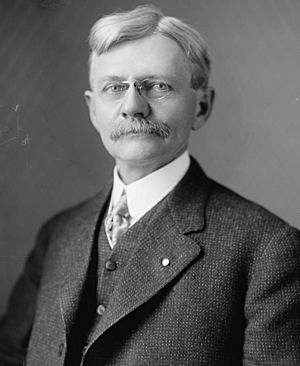
Marshall, about 1910s
|
|
| 28th Vice President of the United States | |
| In office March 4, 1913 – March 4, 1921 |
|
| President | Woodrow Wilson |
| Preceded by | James S. Sherman |
| Succeeded by | Calvin Coolidge |
| 27th Governor of Indiana | |
| In office January 11, 1909 – January 13, 1913 |
|
| Lieutenant | Frank J. Hall |
| Preceded by | Frank Hanly |
| Succeeded by | Samuel M. Ralston |
| Personal details | |
| Born |
Thomas Riley Marshall
March 14, 1854 North Manchester, Indiana, U.S. |
| Died | June 1, 1925 Washington, D.C., U.S. |
| Resting place | Crown Hill Cemetery |
| Political party | Democratic |
| Spouses | Lois Kimsey, 1895 |
| Children | 1 foster son |
| Education | Wabash College (BA) |
| Signature | |
Thomas Riley Marshall (born March 14, 1854 – died June 1, 1925) was an American politician. He served as the 28th Vice President from 1913 to 1921. He worked under President Woodrow Wilson.
Before becoming Vice President, Marshall was a well-known lawyer in Indiana. He was active in the Democratic Party. He gave speeches and organized events. This helped him get elected as the 27th Governor of Indiana. As governor, he tried to change the state's rules. But the Indiana Supreme Court stopped his plans.
Marshall was popular as governor. Indiana was also a key state in elections. This helped him become the Vice Presidential candidate with Wilson in 1912. They won the election. Marshall and Wilson did not always agree. Wilson limited Marshall's power. Marshall was even targeted in an assassination attempt in 1915. This was because he supported joining World War I.
During his second term, Marshall gave speeches to boost morale during the war. He became the first U.S. Vice President to lead cabinet meetings. He did this when Wilson was in Europe for peace talks. As the head of the United States Senate, Marshall helped change a rule. This rule made it easier to pass important laws during wartime.
Marshall's time as Vice President is also remembered for a big problem. President Wilson became very sick in 1919. Wilson's helpers and wife tried to keep Marshall from knowing how sick the President was. They did not want Marshall to take over. Many people asked Marshall to become acting president. But he refused to force Wilson out. He did not want to set a bad example. This lack of strong leadership meant some important plans, like joining the League of Nations, failed. Marshall was the first Vice President in almost 100 years to serve two full terms.
Marshall was famous for his humor. He once joked that "What this country needs is a really good five-cent cigar." After being Vice President, he became a lawyer in Indianapolis. He wrote several law books and his own story, called Recollections. He continued to travel and give speeches. Marshall died in 1925 from a heart attack.
Contents
Early Life and Education
Family and Childhood
Thomas Marshall's family moved to Indiana in 1817. His grandfather, Riley Marshall, became rich when oil and gas were found on his farm. This money helped him become an active member of the Indiana Democratic Party. He even served as an Indiana State Senator.
Thomas's mother, Martha Patterson, was known for her quick wit. She met and married Daniel Marshall, Thomas's father, in 1848. Thomas Riley Marshall was born in North Manchester, Indiana, on March 14, 1854.
When Thomas was young, his family moved many times. They were looking for a better climate for his mother, who had tuberculosis. In 1858, when Thomas was four, his father took him to a famous debate. It was between Abraham Lincoln and Stephen A. Douglas in Freeport, Illinois. Marshall later said he sat on both their laps. He remembered this as one of his favorite early memories.
The family moved to Kansas and Missouri. But violence from the American Civil War made them move back to Indiana. They wanted to be far from the dangerous border areas.
School Days
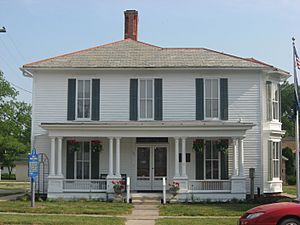
Marshall started public school in Pierceton, Indiana. His family later moved to Fort Wayne, Indiana. There, he finished high school in 1869. At age fifteen, his parents sent him to Wabash College in Crawfordsville, Indiana. He studied many subjects there.
In college, Marshall joined a fraternity. He also wrote for the college newspaper. In 1872, he wrote something about a female lecturer that caused trouble. She sued him for $20,000. Marshall hired Benjamin Harrison, who later became a U.S. President, as his lawyer. Harrison got the lawsuit dropped. Marshall learned a lesson about being careful with his words.
Marshall graduated from college in 1873. He was very interested in law. He learned law by working with a lawyer named Walter Olds in Columbia City, Indiana. Marshall became a lawyer on April 26, 1875.
Starting His Law Career
In 1876, Marshall opened his own law office in Columbia City. He took on many small cases. In 1879, he partnered with William F. McNagny. Their firm became well known. McNagny was good at legal arguments. Marshall was a great speaker in court.
In 1880, Marshall ran for public office for the first time. He ran for prosecuting attorney but lost. The area was a Republican stronghold. Around this time, he met Kate Hooper. They were going to get married, but Kate died in 1882. This was a very sad time for Marshall.
Marshall lived with his parents until his thirties. His mother died in 1894. In 1895, Marshall met Lois Kimsey. She worked at her father's law firm. Even though he was 19 years older, they fell in love and married on October 2. They had a very close marriage. They were almost always together for nearly 30 years.
Marshall became more popular in the Democratic Party. He was part of the state Democratic Central Committee in 1904. He was also a very active Mason. He helped with many Masonic charities.
Governor of Indiana (1909–1913)
Becoming Governor
In 1906, Marshall turned down the chance to run for Congress. But he showed interest in running for Governor of Indiana in 1908. He gained support from labor unions. He also got help from a reporter named Louis Ludlow.
At the state convention, Marshall was not the first choice. But different groups in the party came together to support him. He won the nomination. His opponent was Republican Congressman James E. Watson. The main topic of the election was about banning alcohol. Marshall won by a very small number of votes. He was the first Democratic governor in 20 years.
Making Changes
Marshall became Governor of Indiana on January 11, 1909. He focused on making progressive changes. He helped pass a child labor law. This law stopped young children from working in factories. He also supported laws against corruption.
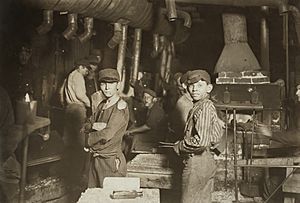
Marshall supported the idea of people directly electing U.S. Senators. This idea later became the 17th Amendment. He also improved how the state's money was checked. He said this saved the government a lot of money.
Marshall did not like the state's eugenics laws. He told state places not to follow them. He was one of the first important people to speak out against these laws. He also did not like the death penalty. No one was executed during his time as governor. He often pardoned people who were sentenced to death.
Marshall also worked to break up large businesses using new laws. He took part in many public events. He even laid the last gold brick to finish the Indianapolis Motor Speedway in 1909.
Vice President (1913–1921)
The Election and His Role
 Marshall could not run for governor again. He planned to run for the U.S. Senate. But then he was chosen as the Vice Presidential candidate for Woodrow Wilson in 1912. Indiana was an important state for winning the election. Wilson hoped Marshall's popularity would help them win there.
Marshall could not run for governor again. He planned to run for the U.S. Senate. But then he was chosen as the Vice Presidential candidate for Woodrow Wilson in 1912. Indiana was an important state for winning the election. Wilson hoped Marshall's popularity would help them win there.
Marshall did not want the job at first. He thought it would be boring. But Wilson promised him important duties. So, Marshall accepted. He traveled around the country giving speeches. The Wilson-Marshall team easily won the 1912 election. This was because the Republican Party was divided.
Marshall and Wilson did not get along very well. Marshall often disagreed with Wilson. Wilson invited Marshall to cabinet meetings, but rarely listened to his ideas. Marshall eventually stopped going to the meetings.
Changes in the Senate
Marshall saw his main job as leading the Senate. He did not mind that Wilson did not ask for his advice much. When he led the Senate, things sometimes got heated. He even threatened to remove some senators for bad behavior. He voted eight times to break tie votes.
Before World War I, some senators tried to stop important bills. They used a tactic called a filibuster. This means they talked for weeks to delay a vote. Wilson wanted Marshall to stop them, but Marshall refused. He believed in free debate.
However, the small group of senators kept blocking pro-war laws. So, Marshall helped the Senate create a new rule on March 8, 1917. This rule allowed filibusters to be stopped by a two-thirds vote. This was a big change. It helped pass important laws during the war.
Because Marshall was seen as a bit funny, some Democrats wanted to replace him in 1916. But Wilson decided to keep him. In 1916, Marshall was re-elected. He was the first Vice President to be re-elected since 1828.
Assassination Attempt
On July 2, 1915, a man named Eric Muenter tried to hurt Marshall. Muenter was against America joining the war. He broke into the U.S. Senate building. He put dynamite near Marshall's office door. The bomb exploded too early, before anyone was in the office.
Muenter was caught later. He admitted he tried to assassinate the Vice President. Marshall was offered security guards after this. But he said no.
World War I and Family Life
During Marshall's second term, the United States joined World War I. Marshall supported the war effort once it began. Wilson sent Marshall around the country. Marshall gave speeches to encourage Americans. He told them to buy Liberty Bonds to help pay for the war. Marshall was good at this job. He often earned extra money as a public speaker.
As the war ended, Marshall made history. He became the first Vice President to lead cabinet meetings. Wilson gave him this job while he was in Europe signing the Treaty of Versailles.
Marshall's wife, Lois, was very involved in charity work. She helped poor children in Washington. In 1917, she met a mother with sick twin babies. Lois felt a strong connection to one of the babies, named Clarence Ignatius Morrison. She offered to take him and help him get treatment.
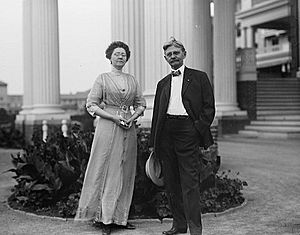
The Marshalls had not been able to have children. Marshall grew to love the boy very much. They never officially adopted him. They wanted to keep the situation private. They called him Izzy. Lois tried very hard to help him get better. But his health worsened. Izzy died in February 1920, just before his fourth birthday. This was a very sad event for Marshall.
Presidential Succession Problem
President Wilson had a serious stroke in October 1919. He became very sick and could not do his job. Wilson's closest helpers and his wife, Edith, did not want Marshall to take over. They tried to keep him from knowing how bad Wilson's condition was.
Many people, including government officials, asked Marshall to become acting president. But Marshall refused. The rules for a Vice President taking over were not clear back then. He did not want to set a new rule by forcing Wilson out. Marshall said he would only take over if Congress asked him to. Or if Wilson himself said he could not do his job.
Wilson's wife and doctor kept him hidden. No one could get official information about his health. Marshall tried to meet with Wilson but could not. A group of Congress members tried to get Marshall to take over. But other senators stopped them. These senators did not want the League of Nations treaty to pass. They thought Marshall would make changes to the treaty that they did not like.
In December, a committee went to check on Wilson. They found he was very sick but could still make some decisions. This stopped the push for Marshall to take over. One day, Marshall was told Wilson had died. He was shocked and announced it in church. But it was a hoax. Wilson was still alive.
Marshall did a few official jobs for the rest of Wilson's term. But Wilson's wife handled most of the government's daily work. The lack of leadership meant the League of Nations treaty failed. Marshall left office in January 1913. It is still unclear who made the big decisions during Wilson's illness.
After Being Vice President (1921–1925)
Marshall thought about running for president in 1920. But he did not get enough support. He then supported the Democratic candidates, but they lost. Marshall joked to the new Vice President, Calvin Coolidge, that he offered his "sincere condolences" for being elected.
Marshall moved to Indianapolis and opened a law office. He wrote books about law and his own story, Recollections. This book was finished in May 1925. It was known for not sharing any secrets or attacking anyone. Marshall continued to be a popular speaker. He gave his last speech to high school students in his hometown.
Death
On June 1, 1925, Marshall had a heart attack in Washington D.C. He died at age 71. Many important people attended his funeral in Washington. His body was taken back to Indianapolis. Thousands of people came to see him. He was buried in Crown Hill Cemetery. His adopted son, Izzy, was buried next to him. His wife, Lois, later moved to Arizona. She lived on his pension and money from his memoir. She died in 1958 and was buried next to her husband.
His Famous Humor
Marshall was known for his quick wit. When he heard he was nominated for Vice President, he joked that Indiana was "home of more second-class men than any other state." He also told a favorite joke about a man with two sons. One drowned at sea, and the other became Vice President. He said neither son was ever heard from again.
Marshall's humor sometimes caused problems. He would greet visitors on White House tours by saying, "If you look on me as a wild animal, be kind enough to throw peanuts at me." President Wilson moved Marshall's office to stop this.
Marshall's most famous joke is still remembered today. In 1914, a senator was giving a long speech about what the country needed. Marshall quietly said, "What this country needs is a really good five-cent cigar." This joke became very popular. Marshall later explained that the cigar was a symbol for simpler times and hard work.
What He Left Behind
The problem with Wilson's illness and Marshall's decision led to a big discussion. People wanted clearer rules for when a president becomes unable to do their job. This issue had come up before, but nothing was done.
Almost 50 years later, after President John F. Kennedy was assassinated, a new rule was made. It was the 25th Amendment. This amendment made it clear how the Vice President can take over if the President is unable to serve.
Historians have different ideas about Marshall's time as Vice President. Some say he was one of the worst. Others argue that his decision not to force Wilson out was the right one. They say it was important not to set a bad example.
Images for kids
-
The Thomas R. Marshall House at Columbia City was listed on the National Register of Historic Places in 1983.
-
The Indiana Statehouse in Indianapolis.
-
Children at an Indiana glass factory. Child labor was ended in Indiana by Marshall's child labor laws.
-
A crowd in Indianapolis listening to Samuel Ralston speak as Thomas Marshall prepares to deliver his acceptance speech for the vice presidential nomination on August 10, 1912.
-
Thomas Marshall and wife Lois in Washington.
See also
 In Spanish: Thomas R. Marshall para niños
In Spanish: Thomas R. Marshall para niños



